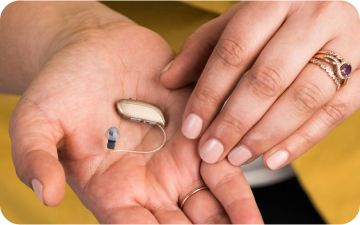
What Is Single-Sided Deafness (SSD)?
Single-Sided Deafness is defined as a loss of usable hearing in one ear while the better ear remains normal or near-normal. Sometimes it happens suddenly, sometimes gradually, and sometimes people are born with it. And while it may seem like single-sided deafness (or SSD) is not that big of a deal, since there’s a “good ear” to rely on, it can still have a major impact on your ability to hear.
We all rely on the use of two ears to tell where sounds are in our environment. Our brains use two main cues called Interaural Level Difference (ILD) and Interaural Timing Difference (ITD) to localize those sounds (there is a third type called HRTF, but we will focus on ILD and ITD for this post). ILD is the difference in volume between your two ears. A sound that comes from your right side should sound louder in your right ear, and a sound from the left side should sound louder in your left ear. That’s because your head creates a shadow in the sound wave, and because the volume of sound dissipates over distance. ITD is the difference in timing between your two ears. A sound that comes from your right side will reach your right ear first, and a sound from the left side will reach your left ear first. Your brain can’t use the ILD and ITD cues to figure out where sounds are when you’re only hearing on one side because of single-sided deafness.
Why Localizing Sound is Important
It’s important for you to be able to tell where sounds are coming from for safety (for obvious reasons) and for hearing in noise. We know that people hear better in noisy environments when they know the location of the target sound. Since SSD impacts our ability to localize sound, it can consequently make it harder to hear in noisy environments. And since few people sit in a quiet room all day without any noise, it’s important to be able to localize sound and hear in noise.
What Can Be Done to Help?
Your options for treating single-sided deafness (SSD) may depend on what caused the hearing loss. And your success with the treatment may depend on how long you’ve been living with SSD.
CROS
CROS, which stands for Contralateral Routing Of Sound, is a system that takes the sound from your poorer ear and sends it to the better one. It does this using a wireless transmission to a hearing aid that you wear on your better ear. This method of restoring sound in the poorer ear has some subjective benefit from users, which is thought to be due to differences in spectral cues (remember the HRTF mentioned earlier?) and interaural timing differences (ITD). While some research has shown that listening with a CROS can help you hear better in a noisy environment, there is little objective evidence to show that it can help you localize sounds. And most patients do not notice a reduction of tinnitus in the poorer ear.
Osseointegrated Device / Bone Anchored Hearing Aid (BAHA)
An osseointegrated device (or BAHA as the Cochlear-brand device is called) works similarly to a CROS system. But, instead of wearing devices on both ears, you wear just one device on your poorer-hearing side. Like the CROS, this device transfers sound over to your better ear; however, it does so using mechanical vibrations instead of a wireless signal. Some studies have shown superior performance of these devices relative to CROS, but neither CROS nor BAHA have demonstrated that they can restore localization for single-sided deafness.
Cochlear Implant
A cochlear implant is a device that restores hearing by stimulating the cochlear nerve with electrical impulses. It was recently approved by the FDA to treat single-sided deafness, whereas previously it was only available with severe to profound hearing loss in both ears. Your insurance may have different rules and may or may not approve a cochlear implant to treat SSD, so keep that in mind when exploring your options. However, cochlear implants restore hearing in the poorer ear (assuming the nerve is intact), rather than sending sound over to the better ear. This has been shown to be an effective method for restoring the ILD and ITD mentioned earlier, and recent studies are showing significant improvement for many patients. Also, since the cochlear implant restores sound to the poorer ear, many patients have noticed a reduction of tinnitus in the poorer ear when using their cochlear implant.
How Do I Know Which Option is Best for Me?
We’ll explore all these options with you and help you figure out which will be the best for you. A lot of the decision will depend on personal preference, some will depend on insurance coverage. Many people make the decision based upon whether or not they are comfortable with having a surgery for the BAHA or cochlear implant options. Call or email us to schedule a consultation for a personalized plan to help you with SSD.

